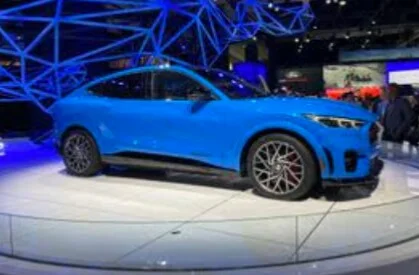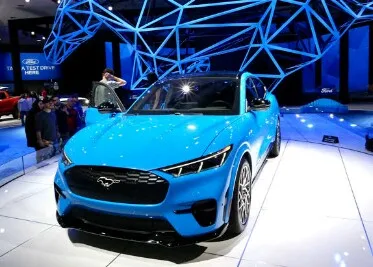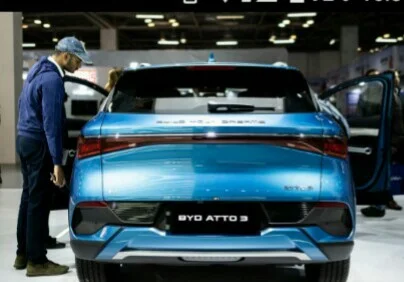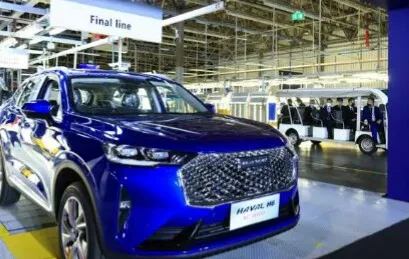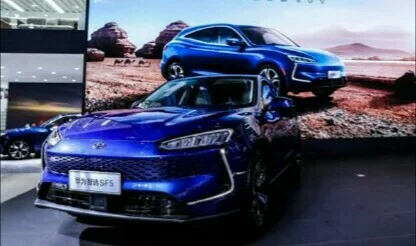Electric Vehicle
Introduction Augmented Reality (AR) Interfaces
Augmented Reality (AR) technology has emerged as a groundbreaking innovation with the potential to revolutionize the way we interact with the world around us.
In the realm of electric vehicles (EVs), AR interfaces are transforming the driving experience by seamlessly integrating digital information into the real-world environment.
In this article, we will explore how AR interfaces are enhancing EVs, improving driver safety, and providing an immersive and futuristic driving experience.
Augmented Reality (AR) Interfaces for Electric Vehicles
| Feature | AR Interfaces | Traditional Interfaces |
|---|---|---|
| User Experience | Immersive and intuitive user experience, providing real-time information and context. | Limited to static displays and physical controls. |
| Information Display | Overlays relevant information directly onto the windshield or other surfaces, such as navigation, vehicle status, and driver assistance. | Relies on displays and gauges within the vehicle's interior. |
| Interaction | Enables hands-free interaction with vehicle functions through gestures and voice commands. | Requires physical interaction with buttons, knobs, and screens. |
| Safety | Improves driver safety by providing critical information at a glance, reducing distractions. | Can be distracting, especially when dealing with multiple displays and controls. |
| Customization | Allows for highly customizable interfaces, tailored to individual preferences and needs. | Limited customization options compared to AR interfaces. |
| Integration | Seamlessly integrates with other vehicle systems, such as infotainment, navigation, and autonomous driving features. | May require multiple interfaces for different functions. |
| Future Potential | Offers a wide range of potential applications, including augmented reality navigation, virtual workshops, and in-vehicle entertainment. | Limited to traditional display and control systems. |
What is Augmented Reality (AR) interfce for the Electric Vehicle
Augmented Reality (AR) interface for the Electric Vehicle (EV) refers to the integration of AR technology into electric vehicles to enhance the driving experience, improve safety, and provide additional information and features for the driver and passengers.
AR interfaces use computer-generated sensory inputs, such as graphics, audio, and haptic feedback, to overlay virtual elements onto the real-world environment, typically displayed on a screen or through projection onto the windshield.
Key Feature Augmented Reality (AR) Interfaces
Some of the key features and applications of AR interfaces for electric vehicles include:
1. AR Navigation: Providing real-time navigation information directly in the driver's view, such as turn-by-turn directions and points of interest, overlaid on the road ahead.
2. Charging Station Finder: Displaying nearby charging stations and relevant information, including availability, charging rates, and station types, to assist with route planning and charging stops.
3. Battery Status Visualization: Showing the current battery charge level, range estimation, and driving range on the AR display.
4. AR Head-Up Display (HUD): Projecting essential driving information, such as speed, navigation instructions, and safety warnings, onto the windshield or a dedicated HUD display.
5. Energy Efficiency Coaching: Providing real-time feedback on driving behavior to encourage more efficient driving and optimize energy consumption.
6. AR-based Maintenance Guides: Assisting users in performing DIY maintenance tasks by overlaying step-by-step instructions onto the physical components of the vehicle.
7. Collision and Obstacle Detection: Using AR to highlight potential obstacles, pedestrians, or hazards on the road, enhancing driver awareness and safety.
8. AR-based Virtual Test Drives and Showroom Experience: Allowing potential customers to experience virtual test drives and explore EV features before purchasing.
9. Gesture and Voice Control: Enabling drivers to interact with the AR interface using gestures or voice commands, minimizing distractions.
10. In-Car Entertainment and Infotainment: Creating interactive and immersive entertainment experiences for passengers during the journey.
The goal of AR interfaces in electric vehicles is to provide drivers and passengers with relevant and contextually useful information while keeping their focus on the road.
By integrating AR technology, electric vehicles can offer a more connected and interactive driving experience, as well as contribute to safer and more efficient driving practices.
It's essential to note that the implementation and availability of specific AR features may vary among different electric vehicle models and manufacturers. The automotive industry is continuously innovating, and new AR applications and advancements may be introduced over time to improve the overall driving experience for EV users.
Type of Augmented Reality (AR) interfce for the Electric
1. Immersive Information Display:
AR interfaces in EVs offer drivers an immersive and intuitive way to access crucial information. Instead of relying solely on traditional instrument clusters or infotainment screens, AR overlays digital data onto the driver's real-world view. Important details, such as speed, navigation instructions, and battery status, can be projected directly onto the windshield or displayed on a heads-up display (HUD), allowing drivers to stay informed without diverting their attention from the road. This immersive information display enhances convenience, reduces distractions, and promotes safer driving.
2. Advanced Navigation and Route Guidance:
AR interfaces revolutionize the navigation experience in EVs by providing real-time, contextually relevant information. Through AR overlays, drivers can see digital arrows, street names, and turn-by-turn directions superimposed on the road ahead. This enables more accurate and intuitive route guidance, especially in complex urban environments. AR navigation also helps EV drivers identify nearby charging stations, providing valuable information for trip planning and reducing range anxiety.
3. Safety and Collision Avoidance:
AR interfaces contribute to enhanced safety in EVs by offering intuitive visual cues for collision avoidance. By using sensors and cameras, AR can detect and highlight potential hazards, such as pedestrians, cyclists, or other vehicles, in the driver's field of view. This augmented awareness helps drivers make split-second decisions and take appropriate evasive actions to prevent accidents. Additionally, AR interfaces can project virtual lines or boundaries onto the road, helping drivers maintain safe distances from nearby objects or navigate narrow spaces with precision.
4. Vehicle Monitoring and Maintenance:
AR interfaces play a vital role in monitoring vehicle performance and maintenance. By leveraging real-time data from the EV's systems, AR overlays can provide drivers with diagnostic information, such as battery health, tire pressure, or charging status. This helps drivers stay informed about the vehicle's condition and take proactive measures to ensure optimal performance. AR interfaces can also guide users through basic maintenance tasks, such as checking fluid levels or replacing filters, by overlaying step-by-step instructions directly onto the physical components.
5. Customization and Personalization:
AR interfaces offer a high level of customization and personalization in EVs. Drivers can tailor the visual appearance of the AR overlays, choosing colors, styles, and data layouts that suit their preferences. This flexibility allows for a personalized driving experience, where drivers can prioritize the information that is most relevant to them. AR interfaces can also integrate with other smart devices and services, such as voice assistants or smart home systems, further enhancing the connectivity and convenience of the EV ecosystem.
Company who produce Augmented Reality (AR) interfaces for Electric Vehicle
The integration of AR technology into vehicles, including electric vehicles, has been a collaborative effort among various automotive manufacturers, technology companies, and research institutions.
Several automotive manufacturers, such as BMW, Audi, Volkswagen, Mercedes-Benz, and Nissan, were actively exploring and developing AR interfaces for their electric vehicle models to enhance the driving experience, provide navigation assistance, and offer other features to the drivers and passengers.
In addition to automakers, technology companies like Apple, Google, Microsoft, and others have been involved in developing AR technologies that could be integrated into electric vehicles.
Since the automotive industry and AR technology landscape are continuously evolving, there may have been new developments and additional companies that have entered the space since my last update.
Technology of Augmented Reality (AR) for the Electric Vehicle
Here are the technologies of Augmented Reality (AR) for Electric Vehicles (EVs)
1. AR Navigation and Route Planning: Overlaying real-time navigation information onto the driver's view, including turn-by-turn directions, points of interest, and charging station locations.
2. Charging Station Finder: Utilizing AR to display nearby charging stations and providing information on availability, charging speed, and pricing.
3. Battery Status and Range Visualization: Showing the current battery charge level, range estimation, and driving range based on the vehicle's current state and driving habits.
4. AR Head-Up Display (HUD): Projecting essential driving information onto the windshield, such as speed, navigation instructions, and safety warnings.
5. Collision and Obstacle Detection: Using AR to highlight potential obstacles and hazards on the road, enhancing driver awareness and safety.
6. Energy Efficiency Coaching: Providing real-time feedback on driving behavior to encourage more efficient driving and extend the vehicle's range.
7. Virtual Test Drives and Showroom Experience: Allowing potential customers to experience virtual test drives and explore EV features before purchasing.
8. In-Car Entertainment and Infotainment: Creating interactive and immersive entertainment experiences for passengers during the journey.
9. Remote Assistance and Maintenance: Enabling remote experts to guide drivers through vehicle maintenance tasks using AR instructions.
10. Gesture and Voice Control: Allowing drivers to interact with the AR interface using gestures and voice commands, reducing distractions.
11. Augmented Vehicle Manual: Providing interactive guides and tutorials for operating various EV features.
12. Smart Parking Assistance: Using AR to assist drivers in finding available parking spots and displaying parking guidelines.
13. Environmental Data Visualization: Providing real-time data on air quality and environmental impact to raise awareness of sustainable driving practices.
14. Solar Panel Efficiency Visualization: Displaying the effectiveness of solar panels on the vehicle's roof in generating power.
15. Driver Training Simulations: Using AR to train new EV drivers in a safe and controlled environment.
16. Smart Grid Integration: Integrating with the smart grid to optimize charging times and reduce energy costs.
17. Vehicle Health Monitoring: Displaying real-time information about the vehicle's performance, maintenance alerts, and potential issues.
18. Vehicle Customization and Personalization: Allowing users to customize and visualize different vehicle configurations using AR.
19. AR-Based Maintenance Guides: Assisting users in performing DIY maintenance tasks through step-by-step AR instructions.
20. Smart City Integration: Interacting with smart city infrastructure to optimize traffic flow and EV charging.
Benefit Augmented Reality (AR) interfce for the Electric Vehicle
The integration of Augmented Reality (AR) interfaces into Electric Vehicles (EVs) offers several benefits that enhance the driving experience, improve safety, and provide additional convenience for EV users.
Some of the key benefits of AR interfaces for electric vehicles include:
1. Enhanced Navigation: AR navigation provides real-time, intuitive directions directly in the driver's view, making it easier to follow routes and find destinations without taking eyes off the road.
2. Charging Convenience: AR interfaces can help drivers easily locate nearby charging stations, check availability, and access charging status, streamlining the charging process and reducing range anxiety.
3. Improved Safety: AR-based collision and obstacle detection systems highlight potential hazards on the road, increasing driver awareness and helping avoid accidents.
4. Energy Efficiency Coaching: AR interfaces can offer real-time feedback on driving behavior, encouraging drivers to adopt more energy-efficient habits, which helps extend the vehicle's range and promote eco-friendly driving.
5. Maintenance Assistance: AR-based maintenance guides provide step-by-step instructions for DIY tasks, simplifying maintenance procedures and reducing the need for professional assistance.
6. In-Car Entertainment and Infotainment: Passengers can enjoy interactive and immersive entertainment experiences during the journey, making travel more enjoyable and engaging.
7. Virtual Test Drives and Showroom Experience: AR allows potential customers to experience virtual test drives and explore EV features before making purchasing decisions, offering a more interactive and personalized car-buying experience.
8. Gesture and Voice Control: AR interfaces with gesture and voice control enable drivers to interact with the system in a hands-free and distraction-free manner.
9. Driver Training: AR can be used to train new EV drivers, helping them familiarize themselves with the vehicle's features and promoting safe driving practices.
10. Personalization and Customization: AR interfaces can offer customizable and personalized settings, allowing drivers to tailor the driving experience to their preferences.
11. Sustainable Driving Awareness: AR interfaces can display real-time data on energy consumption and environmental impact, raising awareness of sustainable driving practices.
12. Seamless Integration with Smart Infrastructure: AR interfaces can integrate with smart city infrastructure, optimizing traffic flow and facilitating efficient EV charging.
By leveraging AR technology, electric vehicles can offer a more connected, interactive, and intuitive driving experience. The combination of AR's informative overlays and EV's eco-friendly attributes contributes to creating a futuristic and sustainable transportation ecosystem. As technology advances, AR interfaces in electric vehicles are likely to continue evolving, providing even more benefits for drivers and passengers.
Manufacture who produce technology of Augmented Reality (AR) for the Electric Vehicle
The list provided includes some of the automotive manufacturers and technology companies that have been actively involved in developing Augmented Reality (AR) technologies for Electric Vehicles (EVs). Let's briefly explain each of them:
1. BMW: BMW is a well-known German luxury automaker that has been exploring AR applications for navigation, vehicle diagnostics, and enhancing the driving experience in their electric and hybrid vehicles.
2. Audi: Audi, a German luxury car manufacturer, has been researching AR HUDs and other AR interfaces to provide drivers with essential information and improve their interaction with EVs.
3. Volkswagen (VW): VW, a German automotive giant, has been investing in AR technologies for use in vehicle navigation, driver assistance, and maintenance support for their electric vehicle lineup.
4. Mercedes-Benz: Mercedes-Benz, a German luxury automaker, has been working on AR HUDs and AR-based user interfaces to improve the driver experience in their electric and autonomous vehicles.
5. Nissan: Nissan, a Japanese automaker, has been exploring AR applications for enhancing vehicle safety, providing maintenance guidance, and delivering an interactive infotainment experience in their electric models.
6. Hyundai: Hyundai, a South Korean automaker, has been researching AR technologies to improve user interaction, navigation, and driver assistance in their electric vehicles.
7. Ford: Ford, an American automaker, has been investigating AR interfaces for in-car entertainment, infotainment, and virtual test drives in their electric vehicle offerings.
8. Tesla: Tesla, an American electric vehicle manufacturer, is known for its innovative approach to EVs and may also be exploring AR technologies for various applications, although they are known for keeping their research and development closely guarded.
9. Apple: Apple, a technology giant, has shown interest in AR technology, and while they have not released an electric vehicle yet, they may explore AR integration if they enter the EV market.
10. Qualcomm: Qualcomm is known for its advancements in mobile technologies and may contribute to AR interfaces for electric vehicles.
11. Microsoft: Microsoft is a technology company that has developed AR technologies like HoloLens, which could be applied to enhance the user experience in electric vehicles.
12. Continental AG: Continental AG is an automotive technology supplier that has been involved in developing AR solutions for electric and autonomous veicles.
13. Bosch: Bosch is another major automotive supplier actively exploring AR interfaces for electric and connected vehicles.
General overview
General overview of potential AR applications in the electric vehicle industry:
1. AR Navigation and Route Planning: Providing real-time navigation information, including turn-by-turn directions and charging station locations, directly in the driver's view.
2. AR HUD (Head-Up Display): Overlaying essential driving information, such as speed, directions, and safety alerts, onto the windshield or a dedicated HUD display.
3. Charging Station Finder: Using AR to identify nearby charging stations and display information on availability, charging rates, and charging station types.
4. Battery Status Visualization: Showing the current battery charge level, range estimation, and driving range based on the vehicle's current state and driving habits.
5. Energy Efficiency Coaching: Providing real-time feedback on driving behavior to encourage more efficient driving and extend the vehicle's range.
6. AR-based Maintenance Guides: Assisting users in performing DIY maintenance tasks through step-by-step AR instructions.
7. Collision and Obstacle Detection: Using AR to highlight potential obstacles and hazards on the road, enhancing driver awareness and safety.
8. AR-based Virtual Test Drives and Showroom Experience: Allowing potential customers to experience virtual test drives and explore EV features before purchasing.
9. Gesture and Voice Control: Enabling drivers to interact with the AR interface using gestures and voice commands, reducing distractions.
10. In-Car Entertainment and Infotainment: Creating interactive and immersive entertainment experiences for passengers during the journey.
11. Remote Assistance and Maintenance: Enabling remote experts to guide drivers through vehicle maintenance tasks using AR instructions.
Future outlook for Augmented Reality (AR) interface for the Electric Vehicle
Here's the future outlook for Augmented Reality (AR) interfaces for Electric Vehicles (EVs)
The future for Augmented Reality (AR) interfaces for Electric Vehicles (EVs) holds immense potential for transforming the driving experience and shaping the future of transportation.
The technology continues to advance and the automotive industry evolves, AR interfaces are expected to play a pivotal role in the following ways:
1. Advanced Navigation and Route Planning: AR interfaces will offer more sophisticated navigation systems, utilizing real-time data and predictive analytics to optimize route planning, taking into account factors like traffic, weather conditions, and charging station availability. This will result in more efficient and convenient journeys for EV drivers.
2. Enhanced Driver Safety and Assistance: AR will play a crucial role in improving driver safety by offering real-time hazard detection, lane departure warnings, and collision avoidance systems. AR interfaces can also provide personalized driver assistance, guiding drivers with context-aware instructions to enhance their driving experience and reduce the risk of accidents.
3. Seamless Integration with EV Systems: AR interfaces will become more seamlessly integrated into the overall EV systems, allowing drivers to access critical vehicle data, battery status, charging information, and other essential features through intuitive and immersive displays.
4. Smart Charging Solutions: AR can assist EV drivers in finding nearby charging stations, predicting charging times, and recommending optimal charging schedules to maximize battery life and reduce charging costs.
5. Vehicle Customization and Personalization: AR interfaces will enable drivers to customize their in-car environment, such as adjusting virtual dashboard layouts, choosing preferred information displays, and tailoring the interface to match individual preferences.
6. AR-based In-Car Entertainment: Passengers can expect more interactive and engaging in-car entertainment experiences, with AR interfaces providing augmented content and immersive entertainment during travel.
7. Integration with Autonomous Driving: As autonomous driving technology advances, AR interfaces can complement self-driving capabilities by providing relevant information to passengers and drivers when the vehicle is in autonomous mode.
8. Augmented Reality Head-Up Displays (AR HUDs): AR HUDs will likely become more widespread, projecting essential information, such as speed, navigation instructions, and warnings, directly onto the windshield, reducing the need for drivers to divert their attention from the road.
9. Energy Efficiency and Eco-Friendly Driving Coaching: AR interfaces can offer real-time feedback on driving behavior to promote eco-friendly driving habits, maximizing the vehicle's energy efficiency and contributing to reduced emissions.
10. Integration with Smart Cities and Infrastructure: AR interfaces can interact with smart city infrastructure, providing drivers with real-time information on parking availability, traffic conditions, and road hazards, contributing to smoother urban mobility.
11. Augmented Reality in Ride-Sharing and Mobility Services: As electric ride-sharing services grow in popularity, AR interfaces can enhance the overall passenger experience, providing virtual information about the journey and local points of interest.
12. Innovative Collaborations and Applications: The future will likely witness innovative collaborations between automotive manufacturers, tech companies, and AR developers, leading to new and creative applications of AR interfaces in EVs.
While the future for AR interfaces in Electric Vehicles is promising, there are challenges to overcome, including cost-effective implementation, user acceptance, and data privacy considerations.
AR technology continues to mature and becomes more accessible, it is expected to revolutionize the way people interact with their electric vehicles, creating safer, more efficient, and enjoyable driving experiences for all.
Conclusion Augmented Reality (AR) interfaces
Augmented Reality (AR) interfaces are reshaping the driving experience in electric vehicles (EVs) by seamlessly integrating digital information into the real world.
With immersive information display, advanced navigation, enhanced safety features, and vehicle monitoring capabilities, AR interfaces enhance driver safety, convenience, and overall satisfaction.
AR technology continues to evolve, we can expect even more sophisticated and intuitive interfaces that will further augment the EV driving experience.
With AR, the future of EVs becomes not just eco-friendly but also exciting, connected, and immersive, paving the way for a new era of transportation.


